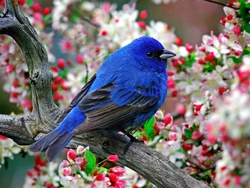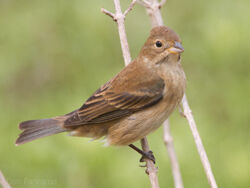| Indigo Bunting | |
|---|---|
 male | |
 female | |
| Scientific classification | |
| Kingdom: | Animalia |
| Phylum: | Chordata |
| Class: | Aves |
| Order: | Passeriformes |
| Family: | Cardinalidae |
| Genus: | Passerina |
| Species: | Passerina cyanea |
The Indigo Bunting (Passerina cyanea) is a well-known North American bunting in the family Cardinalidae.
Description[]
This small finch-like bird measures 5 ½ (14 cm) in length. The adult male in breeding plumage is vibrant and deep blue, but in winter plumage, these colors are obscured by brown and buff edges. The adult female and juvenile are dull brown above and buff below, with a diffusely streaked breast. In late fall, young males molt to a plumage similar to the adult male's winter plumage. They become mostly blue by their first spring.
Voice[]
The male sings well into August, later than most other songbirds. It often sings from treetops. The song is a series of varied, high-pitched phrases, usually paired.
Behavior[]
When migrating, the Indigo Bunting travels at night in flocks of five to ten birds. Males return before females and juveniles, usually returning to the previous year's nesting site.
Feeding[]
The Indigo Bunting feeds on insects, seeds and fruit, and is a common visitor to bird feeders in spring before insects are plentiful.
Breeding[]
The Indigo Bunting lays 3-4 pale blue eggs, which are incubated for 12-13 days. The young fledge at 10-11 days. Nest-building, incubation, and chick-rearing are carried out by the female alone. The Indigo Bunting produces two broods per year.
Distribution and habitat[]
Common in the eastern United States and parts of southeast Canada during the breeding season, the Indigo Bunting is found in woodland clearings and borders and brushy pastures. It winters in Mexico, Central America and South America.
